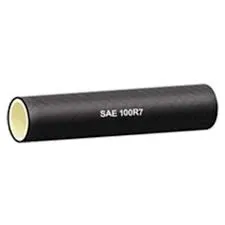Thermoplastic hydraulic hoses feature lightweight, more compact, more flexible, less contamination, custom long length, small I.D. option, non-conductive, and so on, so many advantages result in the primary option in hydraulic hose application, apart from that, Ultra high-pressure thermoplastic hoses are also used in water cleaning industry and hydraulic field.
Thermoplastic hydraulic hoses are made of thermoplastic polymers, like polyester, polyamide, or even fluoropolymers, thermoplastic polymers are melted at high temperatures and molded when cooling down, this intrinsic nature enhances the plasticity of hydraulic hoses.
Thermoplastic hoses are widely used in both mobile and industrial equipment for medium to high-pressure requirements.
Construction of thermoplastic hydraulic hose
Like its rubber counterpart, thermoplastic hydraulic hose is structured in three fundamental layers.
- the inner tube is compatible with the fluids, the material involved is polyester, polyamide, and fluoropolymer;
- The reinforcement provides the needed strength and adequate pressure-holding ability. the reinforcement commonly consists of one or two braided fibers whose material includes polyester, aramid, or steel wire;
- the cover protects the internal tube and reinforcement, and it is typically made of materials like polyester, polyethylene, polyurethane, and PVC.
Since thermoplastic polymers can be re-melted during the manufacturing process, both the inner tube and the outer cover can migrate into the reinforcement layer, which forms a stable integration in the three layers.
THERMOPLASTIC TWIN HOSE SAE 100 R7/ EN 855R7
Advantages of thermoplastic hydraulic hose
Smaller I.D. and long continuous length
When thermoplastic hydraulic hoses are being made on the production line, the mandrel is not required like fabricating rubber hoses, which allows for a smaller inner diameter for thermoplastic hoses, for instance, the minimum I.D. for rubber hose is 3/16″(4.8mm), comparatively, the thermoplastic one is only 1/16″ or smaller. when only a small amount of fluid is needed to transfer, this thin thermoplastic hydraulic hose can come into play.
Due to the same reason, the length of the thermoplastic hydraulic hose is not constricted by the length of the mandrel like rubber hose, the thermoplastic hydraulic hose can be made long enough until the reinforcement fiber is over. some times the length can be up to 8,000 meters.
Due to their re-melting character, two or more thermoplastic hydraulic hoses can be bonded into a single row, which improves the convenience when mounting multiple hoses in the same direction and reduces the likelihood of rubbing each other.
Compact and flexible
The inherent strength of the thermoplastic hydraulic hose allows for thinner tube diameter and wall to support equal flow volume when compared to a rubber hose, which can save space to mount them on the machine, furthermore, inner tubes such as nylon and polyester provide the hose with excellent flexibly, which has half bend radius comparing to the rubber counterpart. these compact and flexible hydraulic hoses can take important roles in a limited room.
Cleanliness
The more smooth inner surface is the inherent character of thermoplastic hose, which permits highly efficient flow and reduces flow loss, moreover, contamination doesn’t exist which comes from lubricant due to mandrel usage. and the plastic tube resists erosion, which contributes to maintaining overall system cleanliness.
Chemical resistance
The thermoplastic hydraulic hose has an excellent chemical-resist character, some synthetic hydraulic fluids such as phosphate ester can’t corrode the thermoplastic tube, in contrast, the rubber hydraulic hoses are not compatible with them.
Non-conductive
Thermoplastic hydraulic hoses have an electrically insulating property, especially for those reinforced with thermoplastic fibers like nylon or polyester. they can be used on occasions requiring non-conductive hydraulic hoses, such as mobile equipment for electrical utilities.
Thermoplastic hose vs rubber hose
In the past years, rubber hydraulic hoses are dominant in hydraulic hose applications, but now, with the development of technology, more and more scenarios adopt thermoplastic hydraulic hoses instead, because they have some advantages such as chemical resistance, flexibility, non-conductivity, and compact size.
But, general thermoplastic hydraulic hoses can’t sustain high temperatures, in the SAE J517 standard, the stipulated high limit is +93°C is a good witness. Moreover, thermoplastic hydraulic hoses can’t withstand high pressure, after all, spiral steel is king, rubber hoses with four or six-plies spiral steel wire can endure more than 45Mpa even in large diameters, but it is never seen thermoplastic hydraulic hoses are reinforced with four steel wire spiraled plies, and rare thermoplastic hydraulic hoses thicker than 1″ are sold on the market.
Conclusion
Thermoplastic hoses have more exclusive features, they are accepted in many applications because they are lightweight, compact, flexible, non-conductive, and so on.

